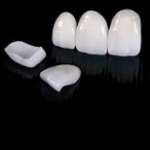Everybody wishes to have beautiful teeth and impressive smiles. Presently there are various dental technologies to create a beautiful smile as well as strong and healthy teeth, under the care of a dentist team of specialists in each field.
A combination of dental works in each field for changing of tooth color, tooth surface, tooth shape, or tooth alignment is a tooth changing for beauty, employing science and arts from various branches of dentistry as follows:
Tooth Whitening is a change for a whiter tooth color by which a dentist and a patient can set the level of required whiteness, based on the following tooth whitening methods:
- In-office Bleaching
- Home Bleaching
- In-office Bleaching and Home Bleaching
In-office Bleaching
is tooth whitening in a dental clinic, which uses light of different wave lengths in each dental bleaching instrument; the light accelerates a whitening process on teeth enamel. In-office bleaching process follows the following procedures:
- A dentist examines the oral cavity health and records teeth color before treatment.
- The dentist provides information on each type of dental bleaching and determines the minimum treatable level of whiteness.
- If the teeth surfaces are covered with plaque or food stains, they shall be first removed before any teeth bleaching.
- Teeth are polished to remove films of microbes.
- Gum and surrounding area are protected with resin.
- Bleaching solution is painted on the teeth surface.
- Light is focused on the teeth to activate the bleaching process; this step may take 45 minutes to 1.30 hours, depending on each type of bleaching processes

- Teeth are veneered with fluorite gel or calcium gel.
Bleaching Instrument at Rang Hill Dental Clinic
- ZOOM
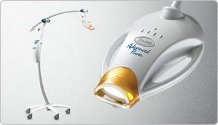
- PLASMA ARC
Home Bleaching
is teeth bleaching using lower concentrated bleaching solution than what is used by a dentist, but the duration of bleaching is longer and the process is as follows:
- A dentist examines the oral cavity health and records the teeth color before treatment,
- If the teeth surface is covered with plaque or food stains, the plaque shall be first removed before the teeth can be bleached,
- If the surface of the teeth shows decay or worn out signs in areas which may contact the bleaching solution, it shall be first filled and repaired before any bleaching,
- The dentist makes a mouth imprint to prepare imitation teeth, taking only 2 minutes to perform the imprint,
- A dental technician prepares a teeth bleaching tray from the imitation teeth, taking about 1.30 hours,
- The dentist tries the teeth bleaching tray and adjust for its fitness to the patient’s mouth cavity membrane,
- The dentist advices the bleaching kit application, including its cleaning,
- The patient can start the bleaching treatment at home by dropping the solution in the bleaching tray and fitting the tray on to the teeth for a specified period (1/2 – 2 hours for 35% solution, and 4-8 hours for 10%-20% solution),
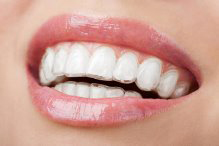
- For the expected maximum efficiency in teeth bleaching, the patient should do home bleaching continually and initially as prescribed by the dentist
Observations after bleaching treatment:
- The teeth are to be cleaned by brushing after each meal and to use floss at least once a day to prevent stains from food and microbe film on dental surface,
- In the case of bleaching by a dentist, to refrain from consuming food and drinks causing stains on the teeth for at least 2 days after bleaching, such as tea, coffee, chocolate, red wine, and all dark color food, inclusive of refraining from smoking for at least 2 days similarly,
- During or after teeth bleaching 1-2 days, teeth sensitiveness may occur, depending on the teeth surface condition, especially decay or worn out teeth, cracked signs, or retracted gum; the said symptoms will decrease and disappear by itself in 1-2 days after the breaching,
- After the bleaching treatment, the whiteness is not stable, depending on food consumption and mouth cavity care. Home bleaching using less quantity of solution but continually every 6-12 months will ensure a stable level of teeth whiteness
A veneer is a restoration of a tooth surface with material or dental work by sticking them to the front surface of a tooth after some filing, to beautify the color, surface, shape and alignment of a tooth, in the following cases:
- A tooth which change color because of its death,
- Blackened teeth because of antibiotics,
- Worn out area, chipped or broke not over a third of the original tooth,
- Too small sized teeth from birth,
- Spaces between teeth,
- Slightly malpositioned teeth that appeared crooked,
Types of Veneer
- Composite resin is a use of composite resin filling to modify the surface of a tooth. The process is the same as filling cavities using composite resin, taking about 40 minutes per tooth,
- Ceramic is translucent and looks natural, having longer useful life than composite resin, but takes more time to process as follows:
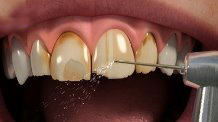 Filing the front surface of a tooth under local area anaesthetic,
Filing the front surface of a tooth under local area anaesthetic,- Impression of teeth as mould and sent the impression to a laboratory for dental technician to prepare a ceramic veneer,
- Setting in place a temporary veneer for 5-7 days use,
- After 5-7 days, the dentist tries the ceramic veneer for its fitness, adjusting it for the patient’s normal bite,
- Fixing the veneer permanently with dental cement,
Observation and care after a tooth veneer
- For a ceramic veneer, avoid chewing food at the position of the particular tooth for 24 hours after fixing,
- For a ceramic veneer, there is the possibility of sensitiveness or swollen gum in some cases. Said discomfort will disappear in 1-3 weeks and the problems can be avoided by
• Washing mouth with salt solution after each tooth brushing,
• Avoiding drinking or eating cold or very hot food, - Take care to avoid biting hard food such as ice, soft bones, hard beans, in the case of ceramic crown or porcelain fused to metal crown as it may crack or break,
- It is recommended to brush teeth after each meal and floss at least once a day,
- Visit a dentist every 6 months for dental check-up.
A dental crown is a teeth repair by employing a dentistry piece work designed in the shape of a tooth and place over a tooth which has been filed around under the following cases:
- A crack in a tooth and beginning to feel sensitive while taking meal,
- A tooth with large cavity filling,
- A broken or chipped tooth from usage or accident,
- A tooth after root canal treatment,
- A deformed or misshapen tooth,
- A misaligned set of teeth,
- Refurnished and repaired level of teeth for normal bite,
- As a composite part in dental bridge or artificial implant
Types of Dental Crowns
Dental crowns are of 3 main types:
- All ceramic crown is a crown made of only ceramic, without any metal part, appropriate for teeth to show beauty, because of its clarity, beauty and nature-like,

2. All Metal crown is made from same type of metal alloy in one piece, thus strong and unbreakable,
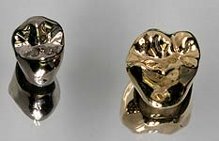
3. Porcelain fused to metal crown, using metal as core and covered outside by ceramic,
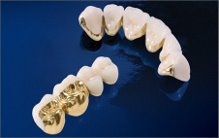
Preparing a tooth for a crown
- Filing a tooth all round under the effect of local area anaesthetic,
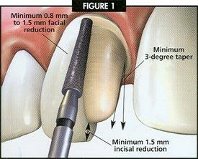
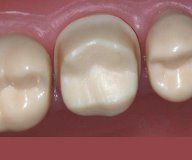
- mpression of the tooth as a mould for a tooth and send it to a laboratory for a dental technician to prepare a crown,
- Set in place a temporary crown for 5-7 days use,
- After 5-7 days, the dentist tries the crown for its fitness, adjusting it for normal bite of the patient,
- Fixing the crown permanently with dental cement,
Observation and care after a crown is placed
- Avoid chewing hard food at the position of the crowned teeth for a period of 24 hours after the crown is placed,
- There is the possibility of sensitiveness or swollen gum in some cases. The said discomfort will disappear soon by itself and you can avoid the problems by
- Washing your mouth with salt solution after each tooth brushing,
- Avoiding drinking or eating cold or very hot food,
- Should avoid biting hard food such as ice, soft bone, hard beans, in the case of ceramic crown or porcelain fused to metal crown as it can crack or break,
- Recommended to brush teeth after each meal and floss at least once a day,
- Visit a dentist every 6 months for dental check-up.
Dental bridges are a method used by dentists to fill a gap created by a missing tooth made up of two dental crowns for the teeth on either side of the gap and a false tooth in between.
Types of Dental Bridges
There are three main types of dental bridges, depending on materials used to make dental crowns as follows:
- All Ceramic bridge
It is all made of ceramic, without any mix of metal, and especially adapted for front teeth requiring beauty, as it is clear, beautiful and looks like natural teeth.
- All metal bridge
It is made of the same kind of metal alloy in one piece and thus strong and withstands chewing well.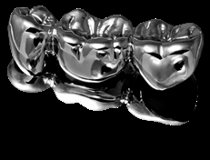
- Porcelain fused to metal bridge
The bridge use metal as an internal core and fused by porcelain on the outside.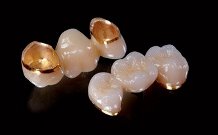
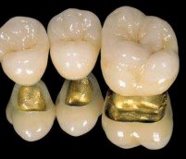
The Dental Bridge Procedure
- Filing down the principle teeth to accommodate the bridge, under local Anastasia,
- Taking impression of the teeth, and send the impression to a laboratory for a dental technician to produce a dental bridge,
- Fixing a temporary bridge for use about 5-7 days,
- After the 5-7 days, the dentist tries the dental bridge piece, and adjusts it for proper chewing of the patient,
- Fixing the dental bridge permanently with dental cement,
Observation and care after a dental bridge
- Avoid chewing hard food at the position of the dental bridge for a period of 24 hours,
- There is the possibility of sensitiveness or swollen gum in some cases. The said discomfort will disappear soon by itself and you can avoid the problems by
- Washing your mouth with salt solution after each tooth brushing,
- Avoiding drinking or eating very cold food,
- Should avoid chewing hard food such as ice, soft bone, hard beans, in the case of ceramic bridge or porcelain fused to metal bridge as the ceramic may crack or break,
- Recommended to brush teeth after each meal and floss at least once a day,
- Visit a dentist every 6 months for dental check-up.
Dental implant is a dental technology which replaces natural lost teeth by implanting materials resembling dental roots into jaws, to enable artificial teeth in the mouth cavity, both of the removable type and the fixed type to hold securely. Another benefit is to help in distribution of chewing force on the jawbones, similar to the natural dental roots which protect jawbones against disintegration caused by the losses of teeth.
Dental implant consists of three main steps:
- The artificial root: it is a material made from titanium, replacing a dental root. It is implanted in the jawbone and the bone will create membrane to fasten the artificial root securely, without causing inflammation to the membrane or causing any side effect on the adjunction bone,
- The abutment: it is a material fixed in each implant to be used as a column to support an artificial crown; there are many types of abutments, depending on the nature of the implants,
- The replacement tooth: It is the imitation part of the natural tooth, which can be a crown, a tooth bridge, or a removable denture.
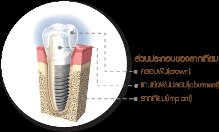
Types of dental implant:
The dental implant is a technology which can be applied to dentistry in three forms as follows:
- A dental implant for a tightly fixed artificial tooth: such as a crown, a bridge, requiring a period of 3-6 months
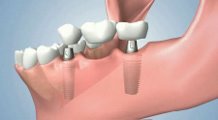
- A dental implant for a removable denture: such as acrylic teeth, metal structured artificial teeth, requiring a period of 3-6 months,
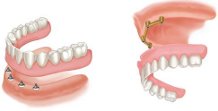
-
A dental implant for immediate use: appropriate for a single implant, in a position which does not receive chewing force, requiring a period of only 1 day – 3 weeks.
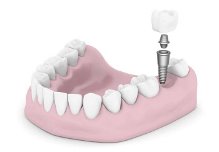
Dental implant procedure:
- The dentist examines the history of chronic diseases and smoking habit, since certain diseases such as diabetes, certain bone diseases, facial x-ray treatment, or smoking may affect the fixing of an implant,
- The dentist examines the mouth cavity health and takes x-ray photos to evaluate health care of the patient’s mouth cavity, and to examine the thickness of the bone supporting the dental implant,
- The operation of the dental implant into the jawbone, under local Anaesthesia, requiring an operating time of approximately 1-2 hours; then, depending on the quality of the jawbone, a period of approximately 3-6 months will be required for a membrane to be formed to hold the dental implant to the jawbone,
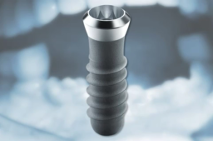
- After the implant has been fixed securely, the dentist will connect the abutment to the implant, and waiting for the gum around the abutment to adjust to the membrane for about 1-2 weeks,
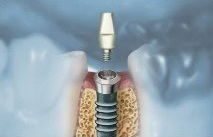
- The dentist prepares a mouth impression for preparation of dentures; this will require a period of 1-3 weeks (depending on the types of the dentures),
- The dentist fixes or puts the denture or crown on the abutment, and provides advice on their care.
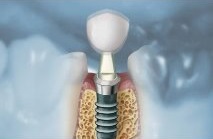
Observance and care after a dental implant:
- During the first week after the operation, soft food should be served and smoking avoided,
- There may be pain and swelling at the operated area during the first week, which you can avoid the said symptoms by:
- Cold compress during the first 48 hours after the operation,
- Warm compress 48 hours after the operation,
- Mouth rinse with salt water after each tooth brushing,
- Taking medicine as advised by the dentist.
- Avoiding chewing food at the position of the dental implant during the first 3 months, so as to prevent impact which might affect the formation of membrane at the implant,
- Brushing your teeth clean after every meal, concentrating on the position of the implant with soft brush and using dental floss normally as natural teeth, once a day,
- Avoiding consumption of hard and tough food,
- Having a dental check-up by a dentist every 6 months.



